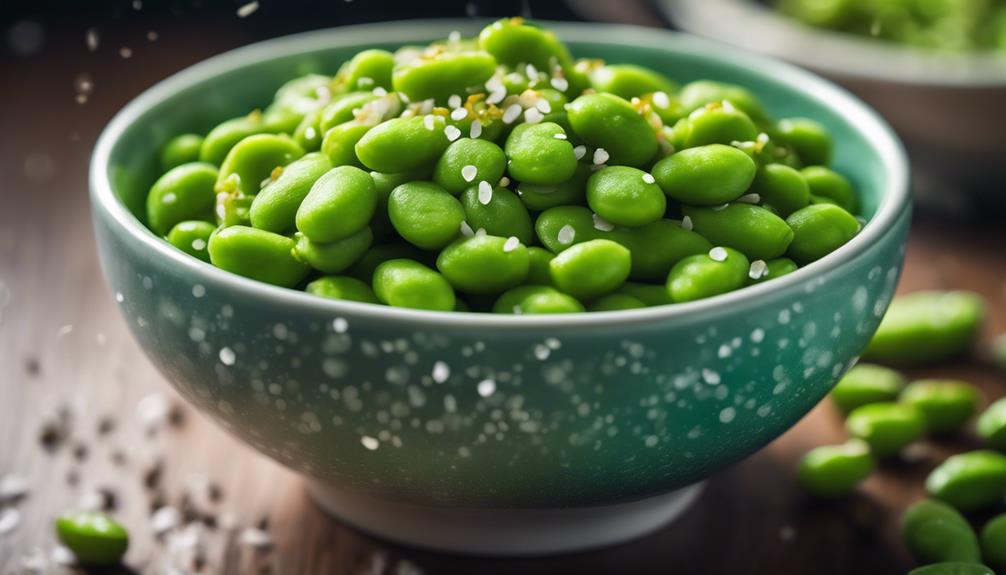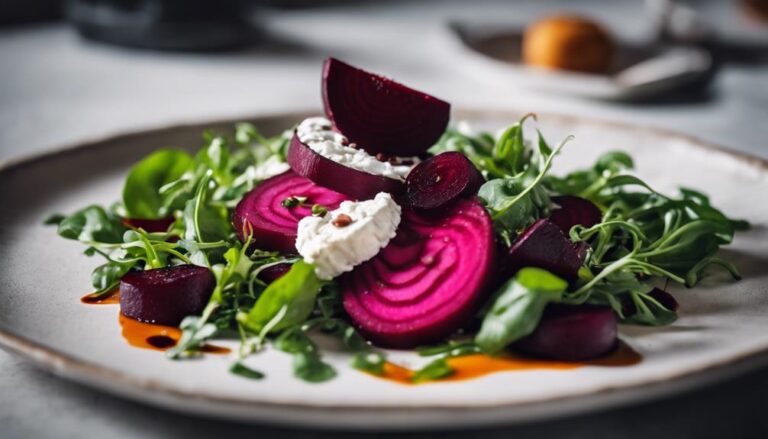Sous Vide Edamame With Sea Salt
For a delicious twist on edamame, try sous vide edamame with sea salt. This simple method enhances the natural flavors of the soybeans. The precise temperature control of sous vide cooking guarantees they stay tender and vibrant green. Seasoned with sea salt, they become a healthy and savory snack or appetizer. If you're curious about the nutritional benefits and culinary possibilities of edamame, this cooking technique is a great way to experience them firsthand. More insights into preparing this trendy dish await you in the details ahead.
What You Will Learn Here
- Sous vide method offers precise temperature control for perfect edamame.
- Preserves nutrients and vibrant green color with sous vide cooking.
- Sea salt seasoning enhances natural flavors without overpowering.
- Enjoy a healthy snack or appetizer with a balance of savory and salty tastes.
- Simple and delicious dish showcasing the natural taste of edamame.
Edamame's Asian Culinary Origins
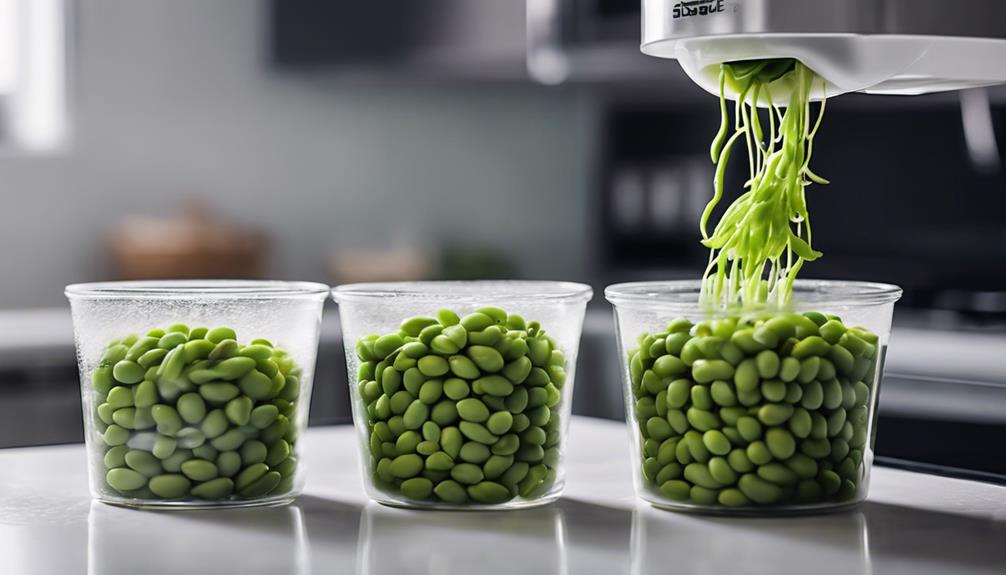
Edamame, a traditional Asian snack, holds a rich history that intertwines with the culinary heritage of several East Asian countries. Understanding its origins not only sheds light on its preparation methods but also reveals the cultural significance attached to this nutritious legume.
Asian Edamame History
Originating in Asia, the culinary history of edamame traces back centuries, reflecting a significant cultural connection to the region's culinary traditions. Soybeans, the main ingredient in edamame, have been cultivated in Asia for over 5000 years. This legume played an important role in Asian diets, providing a rich source of protein and nutrients.
Edamame, young soybeans harvested before they ripen, have been a staple in Asian cuisine for generations. These vibrant green pods are commonly boiled or steamed and served as a nutritious snack or side dish. In Japan, edamame is often sprinkled with sea salt, enhancing its natural flavors.
In Asian cultures, edamame isn't only valued for its taste but also for its health benefits. High in protein, fiber, and antioxidants, edamame is a nutritious addition to any meal. Its versatility in preparation, whether in stir-fries, salads, or simply enjoyed on its own, has made it a beloved ingredient in Asian culinary traditions.
Cooking Techniques Overview
Tracing back centuries in Asian culinary history, the cooking techniques used for edamame are deeply rooted in traditional methods that highlight the natural flavors of this nutritious legume. When it comes to preparing edamame, one modern method that has gained popularity is sous vide cooking. Sous vide offers precise temperature control, ensuring that the edamame is cooked evenly and retains its vibrant green color. This technique also enhances the natural sweetness and crunchiness of the edamame while preserving its nutrients.
In a sous vide vs. traditional methods cooking comparison, sous vide stands out due to its ability to maintain consistent temperatures throughout the cooking process. Unlike traditional boiling or steaming methods, sous vide minimizes the risk of overcooking the edamame, resulting in a more tender texture. Additionally, sous vide allows for the infusion of flavors by vacuum-sealing the edamame with seasonings before cooking. Overall, sous vide cooking provides a convenient and precise way to elevate the flavors of edamame while preserving its nutritional value.
Cultural Significance Analysis
Delving into the rich tapestry of Asian culinary heritage, the cultural significance of edamame unfolds through its traditional preparation methods and historical relevance. Edamame, meaning 'beans on branches' in Japanese, holds deep cultural symbolism as a staple in Asian cuisine. These young soybeans symbolize prosperity and fertility in Japanese culture, often served during celebrations and special occasions. The culinary influence of edamame extends beyond Japan, with other Asian countries incorporating this nutritious legume into their dishes.
Traditional practices of edamame preparation involve boiling or steaming the pods and then seasoning them with sea salt. However, in modern times, edamame has seen various adaptations, such as the sous vide method, which preserves its natural flavors and nutrients. Despite these modern twists, the essence of edamame's cultural significance remains intact, honoring its roots in Asian culinary traditions. Whether enjoyed as a snack or a side dish, edamame continues to bridge the gap between tradition and innovation in the culinary world.
Edamame's Nutritional Benefits
Exploring the nutritional benefits of edamame reveals a rich source of protein and fiber. Edamame, often referred to as a protein powerhouse, offers various health benefits due to its plant-based protein content. Here are four key reasons why incorporating edamame into your diet can be beneficial:
- High Protein Content: Edamame is a great plant-based protein source, making it an excellent option for vegetarians and vegans looking to meet their protein needs.
- Rich in Fiber: Fiber is essential for digestive health, and edamame is packed with it. Including edamame in your meals can help support a healthy digestive system.
- Vitamins and Minerals: Edamame is a good source of vitamins and minerals, such as folate, vitamin K, and manganese, which are important for overall health.
- Low in Calories: Despite being nutrient-dense, edamame is relatively low in calories, making it a great option for those looking to manage their weight while still getting essential nutrients.
Savory Edamame Variations
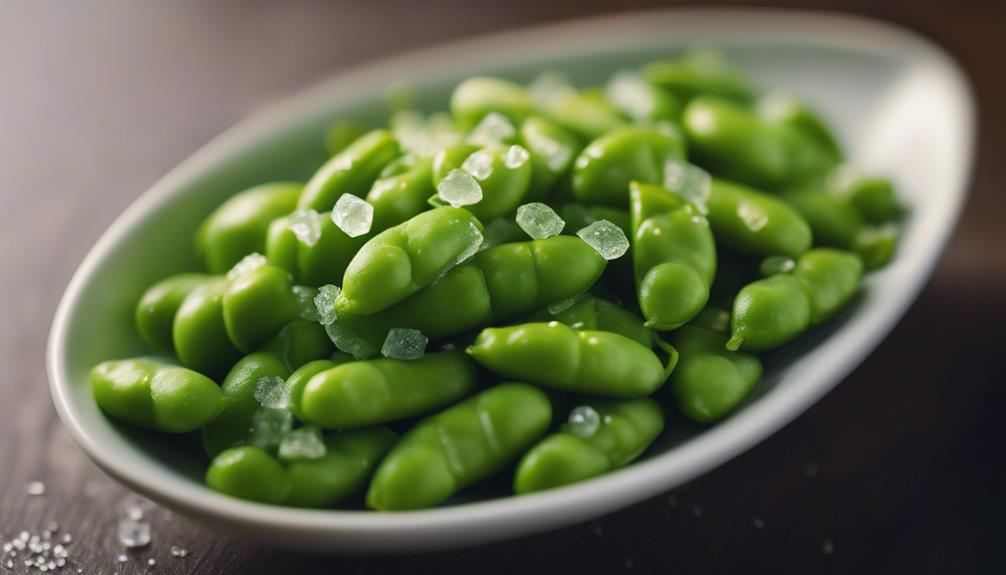
Explore exciting variations of savory edamame such as the Sesame-Ginger Edamame Recipe, Spicy Wasabi Edamame Recipe, and Miso-glazed Edamame Recipe.
These flavorful twists on traditional edamame promise an explosion of taste in every bite, perfect for those seeking new culinary adventures.
Elevate your edamame game with these creative and delicious recipes that are sure to impress your taste buds.
Sesame-Ginger Edamame Recipe
To enhance the flavor of your edamame, consider preparing a delectable Sesame-Ginger recipe that adds a savory twist to this classic dish. The combination of sesame and ginger creates a delightful taste profile that complements the natural sweetness of the edamame beans. This recipe also provides a satisfying crunchy texture that will elevate your snacking experience.
Here's how you can make this delicious Sesame-Ginger Edamame:
- Prepare the Edamame: Boil the edamame beans until they're tender and then drain them well.
- Create the Flavorful Marinade: In a bowl, mix together soy sauce, sesame oil, grated ginger, minced garlic, and a touch of honey.
- Coat the Edamame: Toss the cooked edamame in the marinade until they're well-coated.
- Garnish and Serve: Sprinkle some toasted sesame seeds on top for an extra burst of flavor before serving this delightful dish.
Enjoy your Sesame-Ginger Edamame with friends or as a tasty snack for yourself!
Spicy Wasabi Edamame Recipe
For a bold twist on your edamame snacking experience, try out a Spicy Wasabi Edamame Recipe that will kick up the heat and add an invigorating flavor to this classic dish.
- Ingredients:
- 1 pound edamame, in the pods
- 2 tablespoons soy sauce
- 1 tablespoon sesame oil
- 1 teaspoon wasabi paste
- Instructions:
- Boil edamame pods until tender, then drain and set aside.
- In a bowl, mix soy sauce, sesame oil, and wasabi paste.
- Toss the boiled edamame in the spicy sauce until well coated.
- Serve hot and enjoy the fiery kick of these wasabi edamame appetizers.
- Flavor Profile:
- The combination of soy sauce, sesame oil, and wasabi creates a spicy and savory flavor that complements the natural taste of edamame.
- Serving Suggestions:
- Pair these spicy edamame snacks with a cold beer or a rejuvenating green tea for a delightful snack or appetizer option.
Miso-glazed Edamame Recipe
When looking to elevate your edamame experience with a savory twist, consider trying out a Miso-glazed Edamame Recipe that promises a burst of umami flavor in every bite. Here's a simple recipe to get you started:
- Ingredients:
- 1 lb edamame, pods intact
- 2 tablespoons sweet miso paste
- 1 tablespoon soy sauce
- 1 tablespoon honey
- Instructions:
- Boil the edamame in salted water until tender. Drain and set aside.
- In a bowl, mix the sweet miso paste, soy sauce, and honey.
- Toss the boiled edamame in the miso mixture until well coated.
- Heat a pan over medium heat and sauté the glazed edamame for a few minutes until caramelized.
- Serve:
- Sprinkle some sesame seeds on top for an extra crunch before serving these flavorful miso-glazed edamame pods.
Enjoy the delightful combination of sweet miso and umami flavors that will make this dish a favorite on your table.
Edamame Blanching Technique
When blanching edamame, a quick process is key to retain its vibrant green color and preserve the nutrients.
This technique involves briefly boiling the edamame pods and then immediately cooling them in ice water to stop the cooking process.
Quick Blanching Process
Enhance the edamame's vibrant color and lock in its natural flavors with a quick blanching process before sous viding. When preparing edamame for sous vide, you have the choice between steaming or boiling the pods. Steaming is a gentler method that helps retain more nutrients, while boiling can be quicker but may lead to some nutrient loss. Whether you opt for frozen or fresh edamame also plays a role in the blanching process. Frozen edamame typically requires a slightly longer blanching time compared to fresh pods, as they need a bit more heat to fully thaw and cook through.
To blanch edamame effectively, bring a pot of water to a boil or set up a steaming basket. Add a pinch of salt to the water for extra flavor. Submerge the edamame pods in the boiling water or place them in the steaming basket for a few minutes until they turn bright green and slightly tender. Once blanched, transfer the edamame to an ice bath to halt the cooking process and preserve their vibrant color. This quick blanching step sets the stage for a delicious sous vide edamame dish.
Retaining Vibrant Green
For optimal results in retaining the vibrant green color of edamame during the blanching process, consider adjusting the blanching time based on the edamame's freshness and whether it's frozen or fresh. Color preservation is vital when cooking edamame, as it enhances the visual appeal of the dish. To achieve this, adapt your blanching time accordingly. For frozen edamame, a shorter blanching time is recommended to preserve its green color, while fresh edamame may require a slightly longer blanching time.
Texture retention is also important when using sous vide techniques to cook edamame. By carefully monitoring the blanching process, you can make sure that the edamame retains its firmness and crunch. This method allows you to lock in the flavors and nutrients while maintaining the desired texture. Experiment with different blanching times to find the perfect balance between color preservation and texture retention. These adjustments will help you achieve vibrant green edamame that's both visually appealing and delicious to eat.
Preserving Nutrients in Edamame
To safeguard the nutrients in edamame while employing the blanching technique, maintain a precise and controlled cooking process to lock in the essential vitamins and minerals. Nutrient preservation is vital when cooking edamame to guarantee you benefit fully from its nutritional value. When blanching edamame, it's important to use the correct cooking methods to preserve these nutrients effectively.
Start by bringing a pot of water to a boil and adding a pinch of salt. Once the water is boiling, carefully add the edamame and let them cook for about 3-4 minutes. Avoid overcooking, as this can lead to a loss of nutrients. After the brief blanching period, quickly transfer the edamame to an ice water bath to stop the cooking process. This method, known as blanching and shocking, helps retain the vibrant green color and the nutrients present in the edamame. By following these precise steps, you can enjoy delicious edamame while making sure you get the most out of its nutritional benefits.
Final Thoughts
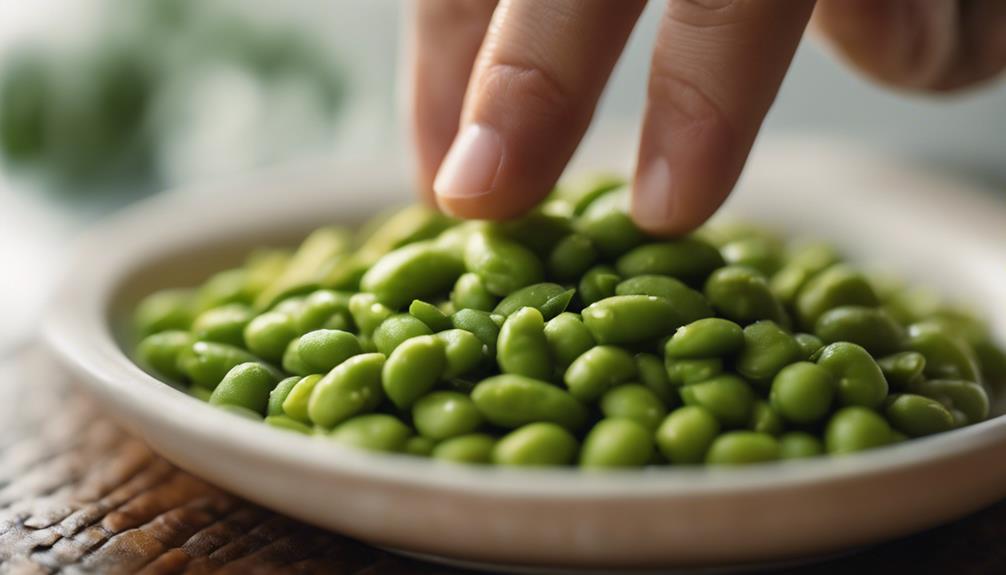
Considering all aspects covered in this article, it's evident that sous vide edamame with sea salt is a simple yet delicious dish that can be enjoyed as a healthy snack or appetizer.
The flavorful seasoning of sea salt enhances the natural taste of the edamame, creating a perfect balance of savory and salty flavors.
The sous vide method guarantees that the edamame is cooked to perfection, preserving its nutrients and vibrant green color.
Frequently Asked Questions
Can Edamame Be Cooked Using Traditional Boiling Methods?
When cooking edamame, boiling is a common method, but steaming often results in a better texture. Consider your texture preferences – if you like a firmer bite, try boiling; for a softer texture, opt for steaming.
Are There Any Alternative Seasonings for Edamame Besides Sea Salt?
For different seasonings on edamame, experiment with flavors like garlic parmesan, chili lime, or sesame ginger. These combinations can add a tasty twist to your edamame, enhancing the snack with unique tastes.
How Can Edamame Be Incorporated Into Desserts or Sweet Dishes?
To incorporate edamame into desserts or sweet dishes, you can try making edamame ice cream or edamame brownies. These unique treats offer a twist on traditional desserts and add a nutritious element to your indulgences.
Does the Size of the Edamame Pods Affect the Cooking Time?
When cooking edamame using sous vide, remember that pod size affects cooking time. Larger pods may require additional time to make sure the edamame reaches the desired tenderness. Pay attention to this detail for perfect texture.
Can Edamame Be Marinated Before Sous Vide Cooking for Added Flavor?
Yes, you can marinate edamame before sous vide cooking for added flavor infusion. Experiment with different marinades like soy sauce, garlic, and ginger. Be sure to vacuum-seal for best marinating techniques. Enjoy the enhanced taste!
Conclusion
To sum up, sous vide edamame with sea salt is a simple and flavorful way to enjoy this nutritious legume.
By using the sous vide method, you can preserve the natural taste and texture of the edamame while enhancing it with a sprinkle of sea salt.
Whether as a healthy snack or a side dish, edamame is a versatile ingredient that can be easily incorporated into your culinary repertoire.
Give it a try and savor the delicious results!
